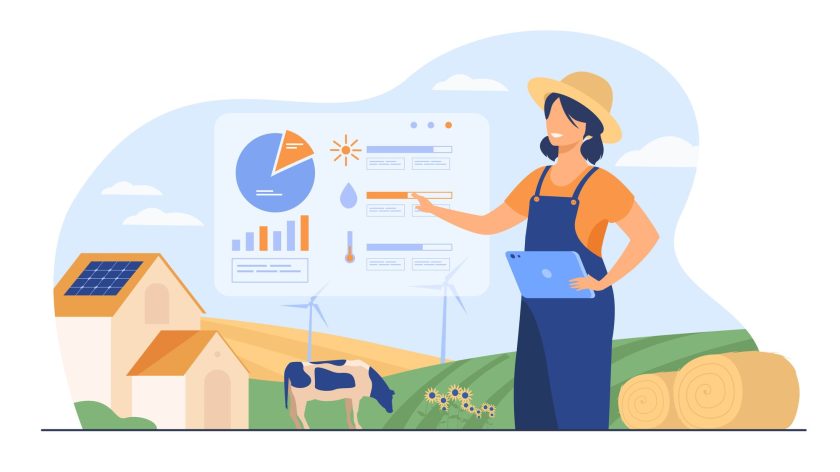Sinking Share of Primary Sector but Rising Employment Figures

This post has been authored by Shrutika Joshi , Economic Analyst Intern at Arthashastra Intelligence
India, a country known for its agrarian economy is now experiencing a diminishing growth in the agriculture and allied activities. Although the sectoral growth is diminishing, the participation of workforce in the said sector is still following a vertical trend. This leads to a question, is India still an agrarian economy?
According to the figure 1, it can be observed that although the workforce participation in agriculture has a sluggish trend but still has the highest share as compared to other sectors since 2010.
India is a developing economy and according to the Office of the Registrar General and Census Commissioner- India, 72.18% population resides in rural areas which concentrates on primary sector activities like agriculture and allied activities, forestry, fishing etc., whereas only 27.81% resides in urban. This is one major reason why primary sector has highest workforce. It is observed that developing economies have comparatively larger labour force and elastic supply of labours willing and able to work. In India, agriculture sector is not only a livelihood to people but also a major source of raw materials to industries and manufacturing companies. In the very early stage of India’s economic development, agriculture had a highest share in GDP which is not the case in present day. The tertiary/ services sector has the highest share in India’s GDP growth. Thus, this brings us to the question on India’s economic nature, is it still agrarian or has shifted to service-oriented nation.
One can observe from the figure above that the primary sector has the least share which is around 21.8% followed by secondary sector 24.29% and 53.89% being the highest share by tertiary/service sector. It has been observed that growth of agriculture sector has been fluctuating from -0.2% in 2014-15 to 6.3% in 2016-17 which again declined to 2.8% in 2019-20. Gross Capital Formation in agriculture as a proportion to GVA has also been fluctuating from 17.7% in 2013-14 to 16.4% in 2012-19 which had dipped to 14.7% in 2015-16. Overall, it can be said that this particular sector of India has been following an unstable trend in terms of growth. Such volatility is causing a tension within the farmers who depends entirely on agriculture and allied activities. In addition to it, they have very less security against the losses.
Recent studies conducted by Credit Suisse observed that rural India is now less dependent on agriculture. The economy can see a rapid transition from agriculture to industry and services in rural areas, especially in the past few decades. Manufacturing sector is booming in rural India making it more of a manufacturing-based area than solely agrarian.
Although, the share of agriculture and its allied activities is diminishing in the GDP growth rate, agriculture has proven to be a remedy amidst the pandemic. The sector saw a growth of 3.4% during the pandemic and has been resilient throughout. Talking about the Food Processing Industries, this sector has been growing at an average rate of 9.99%. Even though there is a growth, agriculture in India has been missing a major advancement which is technology, which is not the case with service sector. Service sector’s significance in Indian economy has been steady and widespread. The sector accounts for approximately 54% of the economy. With the lockdowns the sector contracted but it eventually recovered rapidly.
Talking about India’s exports, it’s climatic conditions, nature and more importantly globalisation has caused an impact on global food basket. Total agriculture commodities exported between March 2020 and February 2021 was US$ 17.9 billion whereas according to RBI, service exports stood at US$ 21.17 billion. Thus, when it comes to revenue from exports, service sector is the leader.
One thing from the analysis is clear that Agriculture is still the backbone of India. It is a sector with highest potential employment opportunities and growth. Although there has been a little shift in consumer habits, India’s agriculture is constantly adapting these habits. India’s rural population still depends on agriculture as a livelihood although the share has reduced. When analysed from employment pattern, India can still be regarded as an agrarian economy. During the difficult times, especially the pandemic, Agriculture and allied activities showed resilience and proved to be economy’s backbone when the other sectors saw contraction. A more focus on technological advancement in agriculture can make India’s agriculture as strong as its service sector. An improvement in agriculture and allied activities will not only make an improvement in GDP contribution but will also be considered as a development pillar. As explained earlier, Food Processing Industries are growing rapidly, such similar advancements will be a game changer. Few improvements like agriculture and related activities can be made export oriented rather than only focusing on higher domestic consumption. This is possible by increasing the produce of slow perishable goods, building High-Tech cold-storage facilities, active participation in trade agreements etc. will once again make the sector stronger.
On the contrary, if one considers exports, share in GDP, development policies, and investments as few parameters to decide an economy’s nature, then it can be said that India is transiting from agrarian to service sector economy. In addition to it, one must note that India unlike other developing nations, shifted from agriculture to services sector directly rather than shifting to manufacturing sector first and then moving to services due to which India has a higher presence in the global service sector.
References
- Data on Workforce distribution Retrieved from Statista: https://www.statista.com/ and Sector-wise GDP distribution Retrieved from http://mospi.nic.in/
- Government of India Economic Survey:2020-21. Chap- 02, Vol -2, New Delhi: Ministry of Finance. Retireved from https://www.indiabudget.gov.in/economicsurvey/doc/vol2chapter/echap07_vol2.pdf
- Government of India Economic Survey:2020-21. Chap – 09, Vol -2, New Delhi: Ministry of Finance. Retireved from https://www.indiabudget.gov.in/economicsurvey/doc/vol2chapter/echap09_vol2.pdf
- Rural India no longer an agrarian economy: Study. The Economic Times. Retrieved from https://economictimes.indiatimes.com/news/economy/agriculture/rural-india-no-longer-an-agrarian-economy-study/articleshow/12852101.cms?from=mdr
